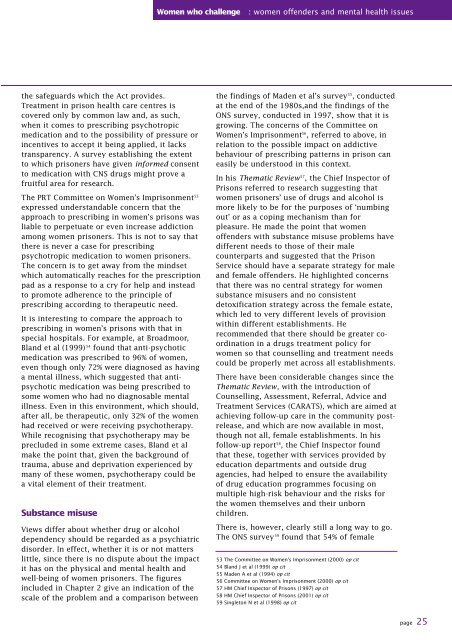Women who challenge - Nacro
Women who challenge - Nacro
Women who challenge - Nacro
- No tags were found...
You also want an ePaper? Increase the reach of your titles
YUMPU automatically turns print PDFs into web optimized ePapers that Google loves.
<strong>Women</strong> <strong>who</strong> <strong>challenge</strong>: women offenders and mental health issuesthe safeguards which the Act provides.Treatment in prison health care centres iscovered only by common law and, as such,when it comes to prescribing psychotropicmedication and to the possibility of pressure orincentives to accept it being applied, it lackstransparency. A survey establishing the extentto which prisoners have given informed consentto medication with CNS drugs might prove afruitful area for research.The PRT Committee on <strong>Women</strong>’s Imprisonment 53expressed understandable concern that theapproach to prescribing in women’s prisons wasliable to perpetuate or even increase addictionamong women prisoners. This is not to say thatthere is never a case for prescribingpsychotropic medication to women prisoners.The concern is to get away from the mindsetwhich automatically reaches for the prescriptionpad as a response to a cry for help and insteadto promote adherence to the principle ofprescribing according to therapeutic need.It is interesting to compare the approach toprescribing in women’s prisons with that inspecial hospitals. For example, at Broadmoor,Bland et al (1999) 54 found that anti-psychoticmedication was prescribed to 96% of women,even though only 72% were diagnosed as havinga mental illness, which suggested that antipsychoticmedication was being prescribed tosome women <strong>who</strong> had no diagnosable mentalillness. Even in this environment, which should,after all, be therapeutic, only 32% of the womenhad received or were receiving psychotherapy.While recognising that psychotherapy may beprecluded in some extreme cases, Bland et almake the point that, given the background oftrauma, abuse and deprivation experienced bymany of these women, psychotherapy could bea vital element of their treatment.Substance misuseViews differ about whether drug or alcoholdependency should be regarded as a psychiatricdisorder. In effect, whether it is or not matterslittle, since there is no dispute about the impactit has on the physical and mental health andwell-being of women prisoners. The figuresincluded in Chapter 2 give an indication of thescale of the problem and a comparison betweenthe findings of Maden et al’s survey 55 , conductedat the end of the 1980s,and the findings of theONS survey, conducted in 1997, show that it isgrowing. The concerns of the Committee on<strong>Women</strong>’s Imprisonment 56 , referred to above, inrelation to the possible impact on addictivebehaviour of prescribing patterns in prison caneasily be understood in this context.In his Thematic Review 57 , the Chief Inspector ofPrisons referred to research suggesting thatwomen prisoners’ use of drugs and alcohol ismore likely to be for the purposes of ‘numbingout’ or as a coping mechanism than forpleasure. He made the point that womenoffenders with substance misuse problems havedifferent needs to those of their malecounterparts and suggested that the PrisonService should have a separate strategy for maleand female offenders. He highlighted concernsthat there was no central strategy for womensubstance misusers and no consistentdetoxification strategy across the female estate,which led to very different levels of provisionwithin different establishments. Herecommended that there should be greater coordinationin a drugs treatment policy forwomen so that counselling and treatment needscould be properly met across all establishments.There have been considerable changes since theThematic Review, with the introduction ofCounselling, Assessment, Referral, Advice andTreatment Services (CARATS), which are aimed atachieving follow-up care in the community postrelease,and which are now available in most,though not all, female establishments. In hisfollow-up report 58 , the Chief Inspector foundthat these, together with services provided byeducation departments and outside drugagencies, had helped to ensure the availabilityof drug education programmes focusing onmultiple high-risk behaviour and the risks forthe women themselves and their unbornchildren.There is, however, clearly still a long way to go.The ONS survey 59 found that 54% of female53 The Committee on <strong>Women</strong>’s Imprisonment (2000) op cit54 Bland J et al (1999) op cit55 Maden A et al (1994) op cit56 Committee on <strong>Women</strong>’s Imprisonment (2000) op cit57 HM Chief Inspector of Prisons (1997) op cit58 HM Chief Inspector of Prisons (2001) op cit59 Singleton N et al (1998) op citpage 25
















